Related Research Articles

An expendable launch system is a launch vehicle that can be launched only once, after which its components are either destroyed during reentry or discarded in space. ELVs typically consist of several rocket stages that are discarded sequentially as their fuel is exhausted and the vehicle gains altitude and speed. As of 2024, fewer and fewer satellites and human spacecraft are launched on ELVs in favor of reusable launch vehicles. However, there are many instances where a ELV may still have a compelling use case over a reusable vehicle. ELVs are simpler in design than reusable launch systems and therefore may have a lower production cost. Furthermore, an ELV can use its entire fuel supply to accelerate its payload, offering greater payloads. ELVs are proven technology in widespread use for many decades.

A spaceplane is a vehicle that can fly and glide like an aircraft in Earth's atmosphere and maneuver like a spacecraft in outer space. To do so, spaceplanes must incorporate features of both aircraft and spacecraft. Orbital spaceplanes tend to be more similar to conventional spacecraft, while sub-orbital spaceplanes tend to be more similar to fixed-wing aircraft. All spaceplanes to date have been rocket-powered for takeoff and climb, but have then landed as unpowered gliders.

The Lockheed Martin X-33 was a proposed uncrewed, sub-scale technology demonstrator suborbital spaceplane that was developed for a period in the 1990s. The X-33 was a technology demonstrator for the VentureStar orbital spaceplane, which was planned to be a next-generation, commercially operated reusable launch vehicle. The X-33 would flight-test a range of technologies that NASA believed it needed for single-stage-to-orbit reusable launch vehicles, such as metallic thermal protection systems, composite cryogenic fuel tanks for liquid hydrogen, the aerospike engine, autonomous (uncrewed) flight control, rapid flight turn-around times through streamlined operations, and its lifting body aerodynamics.
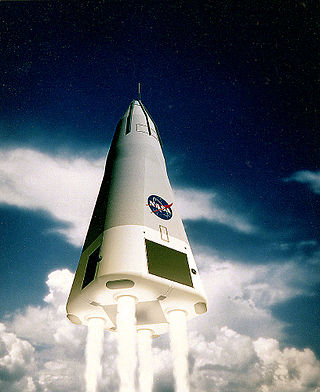
The DC-X, short for Delta Clipper or Delta Clipper Experimental, was an uncrewed prototype of a reusable single-stage-to-orbit launch vehicle built by McDonnell Douglas in conjunction with the United States Department of Defense's Strategic Defense Initiative Organization (SDIO) from 1991 to 1993. Starting 1994 until 1995, testing continued through funding of the US civil space agency NASA. In 1996, the DC-X technology was completely transferred to NASA, which upgraded the design for improved performance to create the DC-XA. After a test flight of DC-XA in 1996 resulted in a fire, the project was canceled. Despite its cancellation, the program inspired later reusable launch systems. Michael D. Griffin has since praised the program as "government R&D at its finest."
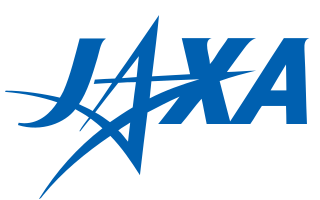
The Japan Aerospace Exploration Agency (JAXA) is the Japanese national air and space agency. Through the merger of three previously independent organizations, JAXA was formed on 1 October 2003. JAXA is responsible for research, technology development and launch of satellites into orbit, and is involved in many more advanced missions such as asteroid exploration and possible human exploration of the Moon. Its motto is One JAXA and its corporate slogan is Explore to Realize.

The M-V rocket, also called M-5 or Mu-5, was a Japanese solid-fuel rocket designed to launch scientific satellites. It was a member of the Mu family of rockets. The Institute of Space and Astronautical Science (ISAS) began developing the M-V in 1990 at a cost of 15 billion yen. It has three stages and is 30.7 m (101 ft) high, 2.5 m in diameter, and weighs about 140,000 kg (310,000 lb). It was capable of launching a satellite weighing 1,800 kg (4,000 lb) into an orbit as high as 250 km (160 mi).
Hopper was a proposed European Space Agency (ESA) orbital spaceplane and reusable launch vehicle. The Hopper was a FESTIP system study design.
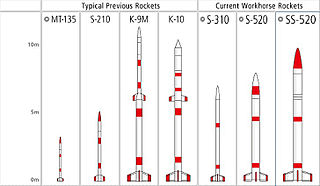
S-Series is a fleet of sounding rockets funded by the Japan Aerospace Exploration Agency (JAXA) that have been in service since the late 1960s. Manufactured by IHI Aerospace and operated by the Institute of Space and Astronautical Science (ISAS). The nomenclature of the S-Series rockets is the number of "S"s indicates the number of stages, and the following number details the diameter of the craft in millimeters. For example, the S-310 is a single stage rocket with a diameter of 310 mm.
Institute of Space and Astronautical Science, or ISAS, is a Japanese national research organization of astrophysics using rockets, astronomical satellites and interplanetary probes which played a major role in Japan's space development. Established as part of the University of Tokyo in 1964, the institute spun off from the university to come under direct purview of the Ministry of Education. Since 2003, it is a division of Japan Aerospace Exploration Agency (JAXA).

H-IIB (H2B) was an expendable space launch system jointly developed by the Japanese government's space agency JAXA and Mitsubishi Heavy Industries. It was used to launch the H-II Transfer Vehicle cargo spacecraft for the International Space Station. The H-IIB was a liquid-fueled rocket, with solid-fuel strap-on boosters and was launched from the Tanegashima Space Center in southern Japan. H-IIB made its first flight in 2009, and had made a total of nine flights through 2020 with no failures.
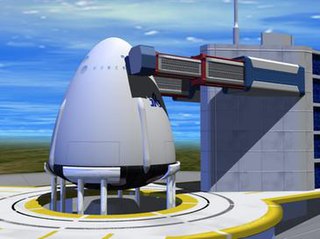
The Kankoh-maru is a proposed vertical takeoff and landing (VTVL), single-stage-to-orbit (SSTO), reusable launch system. According to a document from July 1997, it would have been manufactured by Kawasaki Heavy Industries and Mitsubishi Heavy Industries, with its formal name being the Kawasaki S-1.

The Intermediate eXperimental Vehicle (IXV) is a European Space Agency (ESA) experimental suborbital re-entry vehicle. It was developed to serve as a prototype lifting body orbital return vehicle to validate the ESA's work in the field of reusable orbital return vehicles.
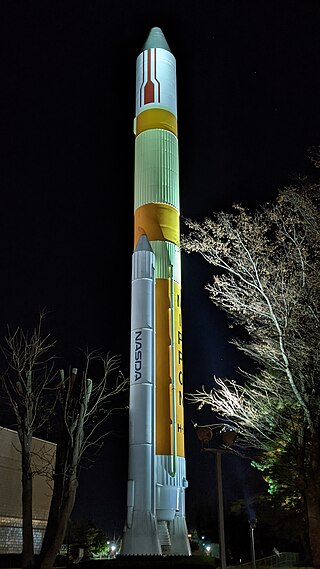
The H-II (H2) rocket was a Japanese satellite launch system, which flew seven times between 1994 and 1999, with five successes. It was developed by NASDA in order to give Japan a capability to launch larger satellites in the 1990s. It was the first two-stage liquid-fuelled rocket Japan made using only technologies developed domestically. It was superseded by the H-IIA rocket following reliability and cost issues.
The Future Launchers Preparatory Programme (FLPP) is a technology development and maturation programme of the European Space Agency (ESA). It develops technologies for the application in future European launch vehicles (launchers) and in upgrades to existing launch vehicles. By this it helps to reduce time, risk and cost of launcher development programmes.
Started in 2004, the programmes initial objective was to develop technologies for the Next Generation Launcher (NGL) to follow Ariane 5. With the inception of the Ariane 6 project, the focus of FLPP was shifted to a general development of new technologies for European launchers.
FLPP develops and matures technologies that are deemed promising for future application but currently do not have a sufficiently high technology readiness level (TRL) to allow a clear assessment of their performance and associated risk. Those technologies typically have an initial TRL of 3 or lower. The objective is to raise the TRL up to about 6, thus creating solutions which are proven under relevant conditions and can be integrated into development programmes with reduced cost and limited risk.

The Noshiro Rocket Testing Center is a facility of the Japan Aerospace Exploration Agency (JAXA), located on the coast of the Sea of Japan in the city of Noshiro in Akita Prefecture, Japan.

The Japanese space program originated in the mid-1950s as a research group led by Hideo Itokawa at the University of Tokyo. The size of the rockets produced gradually increased from under 30 cm (12 in) at the start of the project, to over 15 m (49 ft) by the mid-1960s. The aim of the original research project was to launch a man-made satellite.
The DARPA XS-1 was an experimental spaceplane/booster with the planned capability to deliver small satellites into orbit for the U.S. Military. It was reported to be designed to be reusable as frequently as once a day, with a stated goal of doing so for 10 days straight. The XS-1 was intended to directly replace the first stage of a multistage rocket by taking off vertically and flying to hypersonic speed and high suborbital altitude, enabling one or more expendable upper stages to separate and deploy a payload into low Earth orbit. The XS-1 would then return to Earth, where it could ostensibly be serviced fast enough to repeat the process at least once every 24 hours.

The H3 Launch Vehicle is a Japanese expendable launch system. H3 launch vehicles are liquid-propellant rockets with strap-on solid rocket boosters and are launched from Tanegashima Space Center in Japan. Mitsubishi Heavy Industries (MHI) and JAXA are responsible for the design, manufacture, and operation of the H3. The H3 is the world's first rocket to use an expander bleed cycle for the first stage engine.
WIRES is a Japanese project developing a winged single-stage reusable suborbital rocket as a test bed for a reusable orbital launch system or a crewed suborbital spaceplane. The full-size prototype, called WIRES-X, is expected to be launched in 2020.

CALLISTO is a reusable VTVL demonstrator propelled by a small 40 kN Japanese LOX-LH2 rocket engine. It is being developed jointly by the French (CNES), German (DLR) and Japanese (JAXA) national space agencies.
References
- ↑ "Reusable Rocket Vehicle Test (RVT)". JAXA. ISAS. 2001-07-03.
- ↑ "Reusable Vehicle Test at Noshiro Testing Center". JAXA. ISAS. 2003-10-15. Archived from the original on 2020-09-29. Retrieved 2009-07-14.